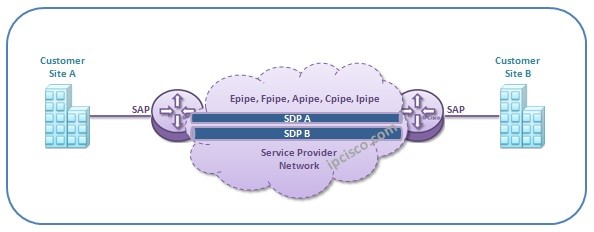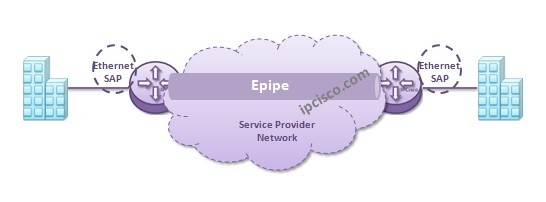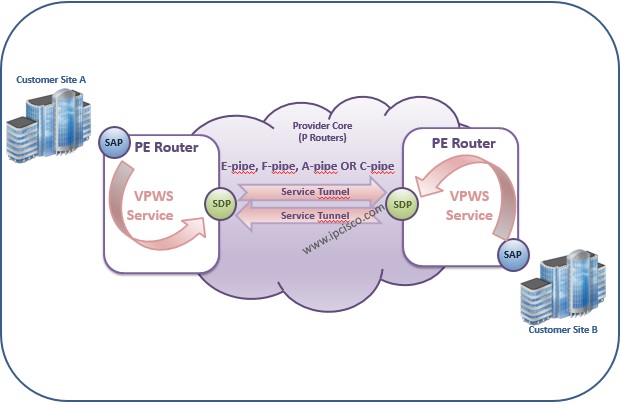- COURSES
- SPECIALS
- BLOG
- MEMBERS
- SHOP
- ABOUT
- ENROLL HERE

Table of Contents
VPWS (Virtual Private Wire Service) is Point-to-Point Layer 2 MPLS VPN Service of Nokia Service Routers. The other Layer 2 VPN Service is VPLS that is explained in another lesson. Here, we will focus on Virtual Private Wire Service . In another lesson, we will learn How to Configure VPWS on Nokia Service Routers.
Below, a logical picture is given for VPWS Service and shows this structure better.

This general structure shows that, VPWS logical structure independant from the used L2 Technology and Virtual Private Wire Service type.
You can view also Local Epipe Configuration, Distributed Epipe Configuration and FPipe, Apipe, Cpipe Configırations Lesson.
VPWS (Virtual Private Wire Service) is also called as Virtual Leased Line. It provides Point-to-Point VPN Service and from the Customer point of view, it is like a Leased Line. With VPWS two sites of customer are like directly connected as Point-to-Point.

VPWS service encapsulates the customer data and transports over the service provider’s IP or MPLS network in a GRE or MPLS tunnel. In other words, customer traffic is encapsulated and transfered over service provider network.
Above, we said that VPWS is a Layer 2 VPN Service. But sometimes Virtual Private Wire Service can be defined as Layer 1 VPN Service. Because there is no MAC learning in this service.
Virtual Private Wire Service offers service for Ethernet, ATM, Frame-Relay and TDM across a common IP/MPLS network. According to used L2 technology, there are five types of Nokia VPWS Services. These are :
Epipe : Epipe is Ethernet Pipe. It is a simple Point-to-Point L2 VPN Ethernet Service between two Ethernet SAPs.
Fpipe : Fpipe is Frame-Relay Pipe. It is a simple Point-to-Point L2 VPN Frame-Relay Service between two Frame-Relay SAPs.
Apipe : Apipe is ATM Pipe. It is a simple Point-to-Point L2 VPN ATM Service between two ATM SAPs.
Cpipe : Cpipe is TDM Pipe. It is a simple Point-to-Point L2 VPN TDM Service between two TDM SAPs.
Ipipe : Ipipe is Interworking Virtual Private Wire Service. It is a simple Point-to-Point L2 VPN Service between two nodes that has different technologies.
Epipe (Ethernet Pipe) is the VPWS VPN Service of Nokia that is for Ethernet Services. In other words, Epipe is a simple Point-to-Point L2 VPN Ethernet Service between two Ethernet SAPs. Epipe Service is also called “Virtual Leased Line (VLL)”.

Fpipe is the VPWS VPN Service of Nokia for Frame-Relay. It is a simple Point-to-Point L2 VPN Frame-Relay Service between two Frame-Relay SAPs. Here, Frame-Relay PVCs are used between routers.

Apipe (ATM Pipe) is the VPWS VPN Service of Nokia for ATM. It is a simple Point-to-Point L2 VPN ATM Service between two ATM SAPs. Here, ATM PVCs are used between routers.

Cpipe is the VPWS VPN Service of Nokia for TDM. It is a simple Point-to-Point L2 VPN TDM Service between two TDM SAPs. Cpipe is like a TDM Leased Line.

Ipipe is Interworking Virtual Private Wire Service. It is a simple Point-to-Point L2 VPN Service between two node that has different layer 2 technologies. For example, an Ipipe can connect an Ethernet technology to an ATM technology, or a Frame-Relay technology to Ethernet technology etc.

As we have discussed before, in VPN Service terminology there are SAPs (Service Access Points) and SDPs (Service Distribution Points). In VPWS, these terms are also used.
On the Service Router, the ports that will connect to customer are defined as SAPs (Service Access Points). Customer access VPN Service over this port. On a physical port, many SAPs (Service Access Points) can be defined. Because SAPs are logical definitions.
Again, on the Service Router, there are other logical definions, SDPs (Service Distribution Points). Here, SDP is used as the tunnel of the VPN Service. There can be many SDPs and each SDP can have one more VPN Service.
Basically, these two terms show the two sides of the Service Router.
VPWS is a Layer 2 VPN Service so it works as other MPLS VPN Services. AS we have discussed before, two label mechanism is used in this VPN Service. So how VPLS Works? Let’s explain this process in five steps:
SAP encapsulation is used for some important roles. According to Layer 2 technology, there are some different encapsulations types. Let’s talk about these encapsulations.
There are some SAPs encapsulations used in Epipe and Ethernet. These encapsulations and their roles are given below:
Null Encapsulation means that this interface can be used for “Single Service” for “Single Customer”.
Dot1q Encapsulation means that this interface can be used for “Multiple Services”for “Multiple Customers”.
Q-in-Q Encapsulation means that this interface can be used to expand VLAN space by tagging tagged packets.
There are also other encapsulation types for SONET. These are :
In the following parts, we will focus on VPWS Configurations on Nokia Service Routers.

Leave a Reply